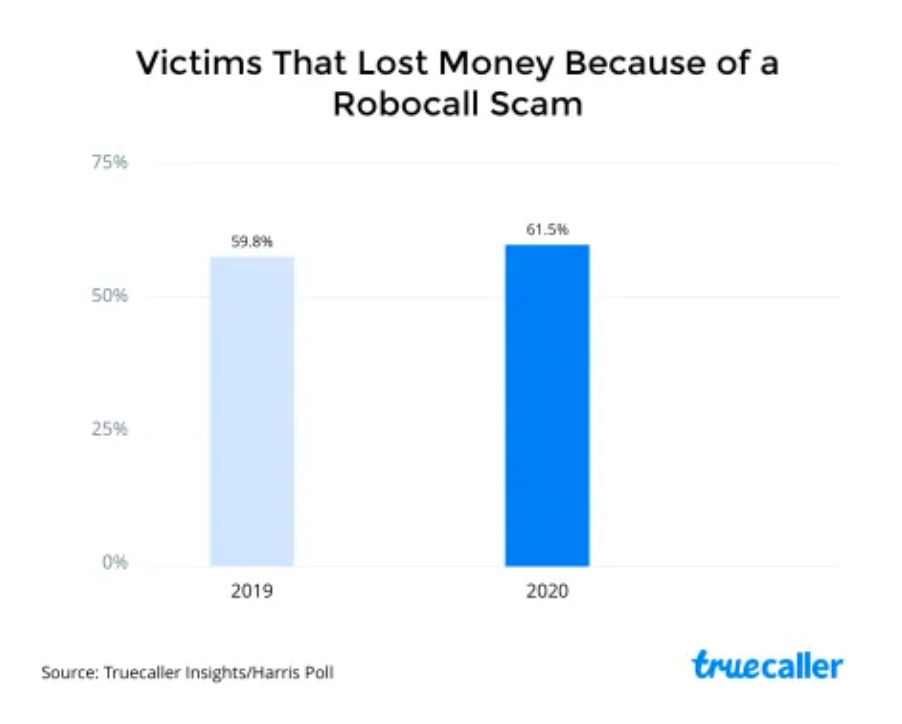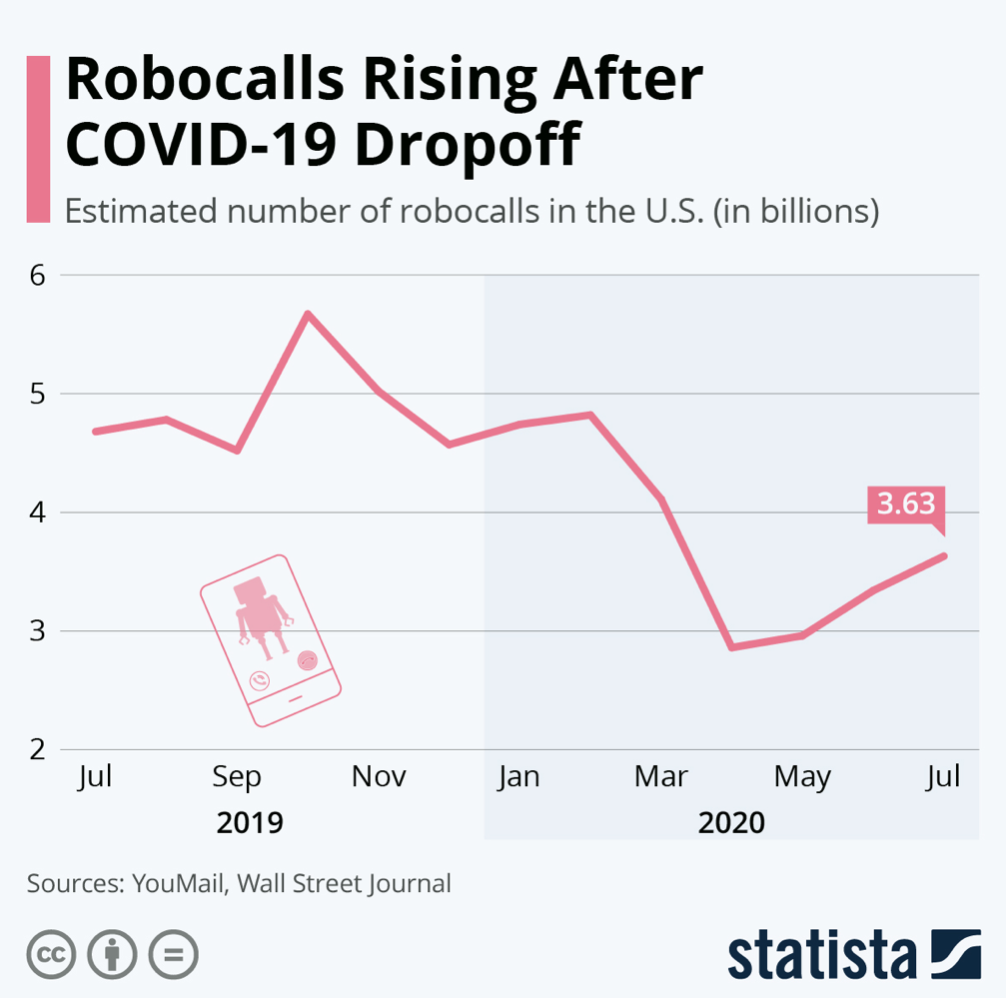Robocalls have long existed as an affordable way for businesses to reach customers. While they have some legitimate purposes, they have mainly evolved into something of a daily annoyance for most people. These automated calls now typically act as a way to scam unsuspecting consumers out of time and money. While robocalls have found ways to adapt to current times, there are ways to stop them.
This article will cover statistics regarding everything you need to know about robocalls in 2021. We’ll cover the following topics:
- Who Makes Robocalls?
- Robocalls are Generally Hated
- Who is Affected by Robocalls?
- Robocalls in the Era of COVID-19
- How to Block Robocalls
- Robocall FAQs
Who Makes Robocalls?
As stated in statistics above, robocalls continue to be on the rise — that’s because scammers are always finding new ways to trick callers into giving up their personal information. These automated calls have some harmless origins.
For example, pharmacies can use them to notify you when prescriptions are ready. But they are now used at alarming rates by illegitimate organizations to execute scams. Here are some statistics showing who makes robocalls.
- The most common types of robocalls are those claiming to be with the Social Security Administration (39%), the IRS (38%), travel companies (36%), and debt collectors (33%) (CNBC).
- Calls from the top five carriers (AT&T, CenturyLink, Comcast, T-Mobile, and Verizon) accounted for 74% of the total number of robocalls in 1H 2020, up from 68% in 1H 2019. (Business Wire)
- In 2019, NetDotSolutions, Higher Goals Marketing, Veterans of America, and Pointbreak Media were fined and banned by the FTC for making billions of robocalls (PC Mag).
- There were only 22.8 billion total robocalls at the midway point of 2020, equaling an annual pace of 45.6 billion, which is slightly below what we saw in 2018. (PR Newswire)
- In September 2020, robocalls averaged 126.9 million calls/day or roughly 1,469 calls/second, up 7% from 118.3 million calls/day and 1,370 calls/second in August. (PR Newswire)
- In July 2020, scam robocalls increased by 12%, to roughly 1.7 billion calls, a substantial 22% increase in telemarketing calls to nearly 500 million calls. (Warranty Informer)
- Americans received just over 3.3 billion robocalls in June 2020, an 11% increase from May. (PR Newswire)
- Despite a marginal decrease compared to 2019 (31.7 spam calls per month) more than half of Americans (55%) report receiving more spam calls (on a mobile or landline) and/or text messages now than they did a year ago, while 18% say they receive fewer. (Truecaller)
- 45.9 billion robocalls were placed nationwide in 2020, equaling roughly 139.7 calls per person affected. (YouMail)
- 18% of consumers reported getting more than three scam calls per day. (PR Newswire)
- Charity fraud more than doubled: Of the consumers who received a call from someone posing as a charity/humanitarian, 58% reported a financial loss. In 2019, only 24% of consumers responded YES to this same question. (PR Newswire)
Robocalls are Generally Hated
From the receiving end of robocalls, there isn’t really any benefit of robocalls. They waste time and sometimes even money for the person receiving the call. The following statistics will cover the negative impact of these automated calls.
Statistics: Robocalls Waste Both Parties’ Time
As answering a robocall never really leads to any legitimate business purpose, they tend to be a waste of time. Sometimes, they even waste the scammers’ time. Here are some statistics outlining just how much time is lost due to robocalls.
- 18% of unidentified calls are answered (Business Wire)
- 9% of calls identified as spam are answered (Business Wire)
- Spam calls typically last 45 seconds. That’s fairly low compared to identified calls from businesses, which last 2 minutes and 58 seconds on average. Moreover, calls from a user’s contact list last an average of 5 minutes and 28 seconds. (Business Wire)
- Spammers wasted a total of 651,176 minutes in 2020. (RoboKiller)
- October 2019 is the high-water mark for robocalls with 5.7 billion robocalls, or over 190 million per day. (Warranty Informer)
- In September, robocalls averaged 126.9 million calls/day or roughly 1,469 calls/second, up 7% from 118.3 million calls/day and 1,370 calls/second in August. (PR Newswire)
- Because 70 percent of consumers do not pick up unknown numbers, scam callers are now spoofing the numbers of legitimate businesses in an effort to also spoof caller ID services. This method has been dubbed “enterprise spoofing”. (FirstOrion)
Statistics: Robocalls are Costing People Money

Unfortunately, robocalls are typically deployed as ways to scam people out of money. When the scams work, they tend to be very costly. These statistics are a look at how much robocalls are costing people.
- Americans already have lost north of $13.4 million to coronavirus-related robocalls as of May 2020. (CNBC)
- Between mid 2019 to mid 2020, over 56 million Americans lost money to phone scams – this is a 30% increase compared to last year’s 43 million. (Truecaller)
- The average reported loss to scam calls has increased 44% in the past 12 months. (Truecaller)
- Consumers reported losing over $1.8 billion to fraud in 2019. (FTC)
- Consumers who said they were 60 and older (older adults) filed 318,850 fraud reports with reported losses of more than $440 million. (FTC)
- Older adults lose an estimated $2.9 billion each year to financial scams. (AARP)
Who is Affected by Robocalls?
Robocalls don’t discriminate — anyone can fall victim to these scams. But certain demographics tend to be hit harder by robocalls than others. Here are some statistics about who is affected by these calls.
- Older Americans tend to be the hardest-hit when it comes to scam robocalls. (CNBC)
- 89% of seniors receive at least one robocall per week, while more than half (56%) receive at least seven robocalls per week. (Business Wire)
- Texas and California residents got the most robocalls in 2019 at more than 6 million. (USA Today)
- Residents of Washington, D.C., got the most robocalls, averaging nearly two each day (a total of 599 for the year, 1.6 calls daily). (USA Today)
- The states with the biggest increases in robocalls were West Virginia (55%) and Idaho (51%). (USA Today)
- Americans fell victim to mobile phone scams 270% more often in 2020. (PR Newswire)
Robocalls in the COVID-19 Era

After the COVID-19 pandemic hit, robocalls changed and adapted. During the beginning of the pandemic, the general number of robocalls began to dip. But they eventually adapted to the circumstances of the pandemic and found new ways to scam people. Here are some statistics outlining robocalls in the time of the coronavirus.
- The FTC’s latest Do Not Call Registry data shows robocall complaints were down 68% in April 2020 compared to April 2019 and down 60% in May 2020 compared to May 2019. (FTC)
- July 2020’s numbers are 36% below the all-time high, but illegal robocalls are rising steadily since the April 2020 low-point of 2.8 billion calls. (Warranty Informer)
- The most common robocalls related to the virus are those claiming to provide treatment (22%), financial relief (18%) and free Covid-19 testing (18%). Another 15% said they’d received a robocall call or text regarding their stimulus check from a scammer claiming to be from the IRS. (CNBC)
- According to a survey, 20% of those polled have received a call or text regarding the illness. (Provision Living)
- The COVID-19 stay-at-home mandate has put a significant dent in robocall campaigns, driving a 15% drop in unwanted calls in the first half of 2020 compared to the same period during the prior year. (Business Wire)
- 44% of Americans received spam calls related to COVID-19 in 2020. (Truecaller).
How to Block Robocalls
Robocalls don’t have to be an unavoidable nuisance. From FCC complaints to robocall blockers, there are numerous ways to block those unwanted calls. Here are some statistics on ways to block robocalls.
- YouMail has 10 million users, answered 10 billion calls, and stopped over 1 billion robocalls (YouMail)
- Hiya reports that 54.6 billion unwanted robocalls were placed to U.S. mobile phones in 2019. (FCC)
- Unsolicited robocalls are the #1 source of consumer complaints to the Federal Communications Commission and Federal Trade Commission. (Hiya)
- 52% of respondents do not answer calls from unfamiliar numbers from outside their area code (Business Insider)
- 40% of respondents signed up for the Do Not Call Registry. (Business Insider)
- 35% of respondents screen their incoming unknown phone calls, then google the phone number. (Business Insider)
- RoboKiller blocked 16,485,324 spam calls in December 2020. (RoboKiller)
- As a result of losing money to a phone scam in the past 12 months, nearly half (47%) downloaded a spam blocker and/or caller ID app and 34% canceled their credit card/changed account numbers. (Truecaller)
- While the FCC voted to authorize carriers to block incoming calls, a consumer survey released earlier in 2019 found only 39% of U.S. wireless subscribers would like their carrier to automatically block all calls from numbers not in their mobile phone contact list. (TNSI)
- More than 70% of consumers surveyed agree that they would like to use an app from their wireless carrier to identify potential robocalls. However, they are not aware that such an app is offered. (TNSI)
- Younger subscribers are more open to automatic call blocking. Nearly half (48%) of respondents age 25-34 would like carriers to automatically block all calls from numbers not on their contact list, well above the 39% of all survey respondents. (TNSI)
Conclusion: Robocalls Aren’t Going Away
The tough truth is robocalls aren’t going away anytime soon. But staying on top of current statistics will ensure you don’t fall victim to them and have multiple options for blocking the unwanted automated calls.
If you currently use a business phone service for your business needs, learn how you can utilize call screening as an extra line of defense against spammers.
Some are and some aren’t legal. For example, a call trying to sell you something is illegal, unless they already had your permission to call. On the other hand, charities asking for donations can legally use robocalls.
If you answer, don’t press any buttons. Immediately hang up and file a complaint with the FTC and the National Do Not Call Registry.
Some phone carrier providers will offer free robocall blocking features. Expect an additional fee with any third-party robocall blocker application.








